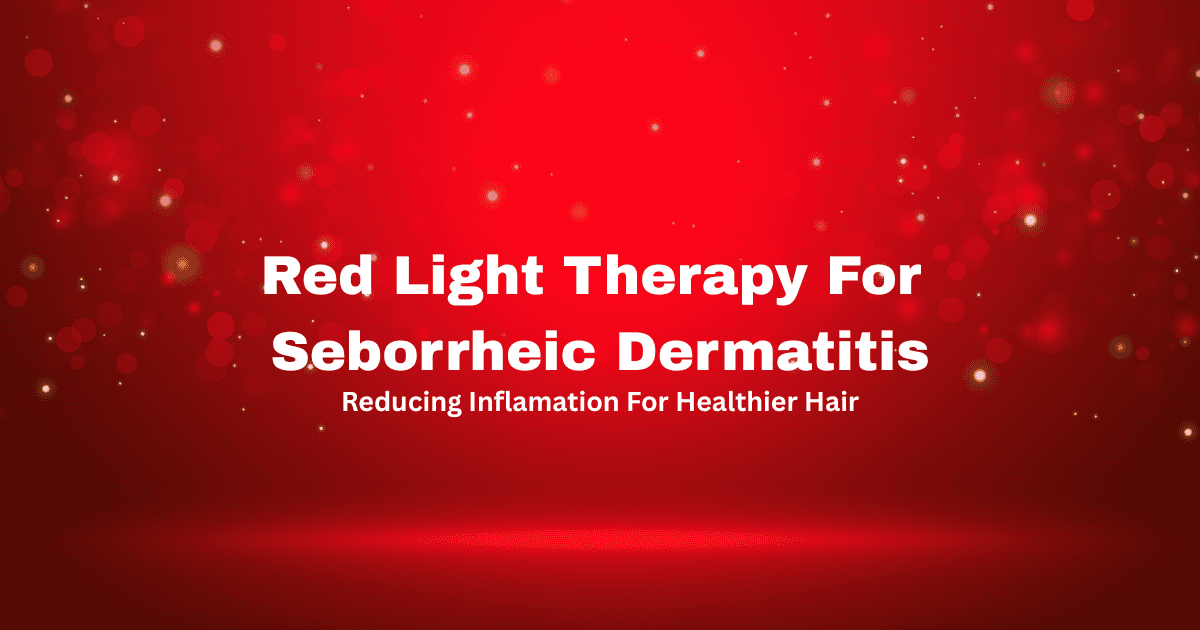Seborrheic dermatitis is a chronic skin condition that affects areas rich in sebaceous glands, such as the scalp, face, and chest. It causes redness, flaking, and greasy scales, often accompanied by itching or discomfort.
Traditional treatments like medicated shampoos and antifungal creams can help but may not work for everyone. Red light therapy (RLT) has emerged as a promising, non-invasive option to manage symptoms by reducing inflammation and promoting skin health.
Key Takeaways:
- Red light therapy (RLT) reduces inflammation and regulates sebum production, addressing the root causes of seborrheic dermatitis.
- Clinical studies show that RLT improves symptoms in up to 83% of patients with moderate to severe cases.
- FDA-cleared devices with wavelengths between 600 and 850 nm are most effective for treating seborrheic dermatitis.
- The best results are obtained through consistent use—10–20 minutes per session, 2–5 times per week.
Related: Postpartum Hair Loss: How Red Light Therapy Can Restore Your Hair After Pregnancy
What Is Seborrheic Dermatitis?
Seborrheic dermatitis is an inflammatory skin condition characterized by:
- Redness and flaking: Often seen on the scalp, eyebrows, and around the nose.
- Greasy scales: Caused by excess sebum production.
- Itching or burning: Common during flare-ups.
Causes and Triggers
The exact cause is not fully understood, but contributing factors include:
- Overgrowth of Malassezia yeast: This naturally occurring yeast can trigger inflammation when its population becomes unbalanced.
- Excess sebum production: Sebaceous glands produce too much oil, creating an ideal environment for yeast growth.
- Environmental factors: Cold weather and stress can worsen symptoms.
- Hormonal changes: Fluctuations during puberty or pregnancy may exacerbate the condition.
How Red Light Therapy Works for Seborrheic Dermatitis
Red light therapy uses specific wavelengths (600 to 850 nm) to penetrate the skin and stimulate cellular processes. Here’s how it helps:
1. Reduces Inflammation
Inflammation is a key driver of seborrheic dermatitis symptoms. RLT decreases pro-inflammatory cytokines, calming redness and swelling[1].
2. Regulates Sebum Production
Overactive sebaceous glands contribute to greasy scales. RLT helps normalize sebum production by modulating sebocyte activity[1][3].
3. Inhibits Malassezia Growth
While not directly antifungal, RLT improves skin conditions that discourage yeast overgrowth, indirectly reducing its impact[3].
4. Promotes Skin Healing
RLT stimulates ATP production in skin cells, accelerating repair and improving the skin barrier function[1]. This reduces irritation and water loss.
Clinical Evidence Supporting Red Light Therapy
Several studies highlight the effectiveness of RLT for seborrheic dermatitis:
- A study published in the Journal of Cosmetic and Laser Therapy found that 83% of patients experienced significant symptom improvement after six weeks of RLT[1].
- Another study demonstrated that combining red (630 nm) and blue (415 nm) light reduced sebum production and inflammation markers like PPAR-γ[3].
- Home-use LED devices combining red and blue light showed reductions in erythema (redness), scaling, and itching after eight weeks of consistent use[2].
Related: Red Light Therapy For Different Hair Loss Types
Comparing Treatments: Traditional vs. Red Light Therapy
| Treatment Method | Benefits | Limitations |
|---|---|---|
| Medicated Shampoos | Reduces scaling and yeast growth | May cause dryness or irritation |
| Antifungal Creams | Targets Malassezia directly | Requires daily application |
| Topical Steroids | Relieves inflammation quickly | Risk of thinning skin with prolonged use |
| Red Light Therapy (RLT) | Non-invasive; reduces inflammation; promotes healing | Requires consistent use over weeks |
How to Use Red Light Therapy for Seborrheic Dermatitis
Step 1: Choose the Right Device
Look for FDA-cleared devices designed for skin conditions:
- Wavelengths between 600 and 850 nm are most effective.
- Scalp-specific devices like headbands or panels ensure even coverage.
Step 2: Establish a Routine
Consistency is key:
- Use RLT for 10–20 minutes per session, 2–5 times weekly.
- Avoid overuse to prevent irritation.
Step 3: Pair with Gentle Skincare
Combine therapy with a routine designed for sensitive skin:
- Use mild cleansers free from fragrances.
- Apply moisturizers that support the skin barrier.
Practical Tips for Effective Treatment
- Start Slowly: Begin with shorter sessions to assess your skin’s response.
- Track Progress: Monitor changes in redness, scaling, and itchiness weekly.
- Avoid Harsh Products: After therapy sessions, avoid alcohol-based toners or harsh shampoos.
Recommended Devices for Scalp Treatment
| Device Name | Features | Price Range |
|---|---|---|
| HairMax LaserBand 41 | Hands-free design; 655 nm wavelength | $199–$299 |
| Laduora DUO | Combines red light with scalp massage | $299 |
| Celluma RESTORE | Flexible design; FDA-cleared | $899 |
These devices are effective when used consistently over several weeks.
Conclusion
Red light therapy is a promising, non-invasive approach for managing seborrheic dermatitis. By targeting inflammation, regulating sebum production, and promoting skin healing, this innovative treatment addresses the root causes of this persistent condition.
Clinical studies demonstrate its effectiveness, with up to 83% of patients experiencing significant symptom improvement.
Red light therapy offers a gentle yet powerful option for those seeking alternatives to traditional treatments. Its ability to reduce redness, scaling, and itching without side effects makes it particularly appealing. However, success hinges on consistency—regular sessions over several weeks are key to achieving and maintaining results.
As we explore new frontiers in dermatological care, red light therapy stands out as a beacon of hope. It alleviates symptoms and promotes overall skin health, potentially reducing the frequency and severity of flare-ups. For individuals struggling with seborrheic dermatitis, this therapy could be the turning point in reclaiming comfort and confidence in their skin.
Related: Female Pattern Hair Loss: How Red Light Therapy Offers a Hormone-Free Solution
Citations:
[1] https://www.bestqool.com/blogs/news/the-newest-findings-of-phototherapy-for-seborrheic-dermatitis
[2] https://www.koreamed.org/SearchBasic.php?RID=1731193
[3] https://pmc.ncbi.nlm.nih.gov/articles/PMC8423200/









Leave a Reply